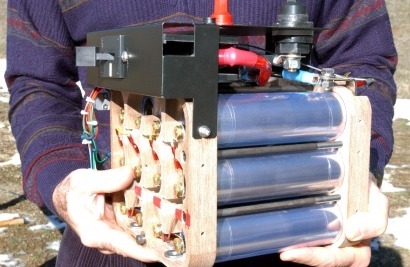
Scientists from the US Department of Energy (DOE) and Stanford University have developed a battery that does not require a separating membrane and can be made from inexpensive components. Yi Cui, an associate professor of materials science and engineering at Stanford, and a number of his colleagues have reported their research results in the May issue of Energy & Environmental Science.
“For solar and wind power to be used in a significant way, we need a battery made of economical materials that are easy to scale and still efficient” said Professor Cui. “We believe our new battery may be the best yet designed to regulate the natural fluctuations of these alternative energies.”
At present the electrical grid cannot tolerate large and sudden power fluctuations caused by wide swings in sunlight and wind. However, the contribution to the electrical grid made by solar PV and wind power has started to approach 20 percent and so electrical storage systems must be developed in order to even out the peaks and valleys of what some describe as an ‘intermittent’ power source. These systems must be able to store excess energy and discharge it when input drops.
The most promising developments in this field are “flow” batteries because it is relatively simple to scale their tanks, pumps and pipes to the sizes required in order to handle large energy capacities. The new flow battery developed by Cui and his team has a simplified and less expensive design that could potentially be a viable solution for large-scale production.
At present, flow batteries pump two different liquids through an interaction chamber in which dissolved molecules undergo chemical reactions that store or discharge energy. This chamber contains a membrane that only allows ions not involved in reactions to pass between the liquids while keeping the active ions physically separated. However, this design has two major drawbacks in that the liquids, which contain rare materials such as vanadium, are fairly expensive, particularly with regard to the huge quantities needed for grid storage, and secondly, the membrane itself is also very expensive and requires frequent maintenance.
The new battery design uses only one stream of molecules and therefore does not need a membrane at all. Its molecules mainly consist of lithium and sulphur, both of which are relatively inexpensive. These two chemicals react with a piece of lithium metal coated with a barrier that permits electrons to pass through without degrading the metal. The molecules, called lithium polysulfides, absorb lithium ions when the battery is discharging and lose them back into the liquid when the battery is charging. The entire molecular stream is dissolved in an organic solvent which doesn’t have the corrosion issues of water-based flow batteries.
“In initial lab tests, the new battery also retained excellent energy-storage performance through more than 2,000 charges and discharges, equivalent to more than 5.5 years of daily cycles.” Cui added.
The researchers have created a mini version of their system using simple glassware and this could be scaled up into a utility version which would store many megawatt-hours of electricity. The next stage is to create a laboratory-scale version in order to optimize the energy storage process and identify potential engineering issues with a view to starting discussions with potential hosts for the deployment of a full-scale field-demonstration unit.
Further information:

